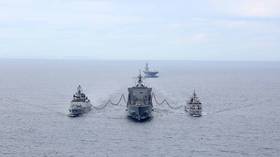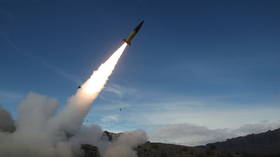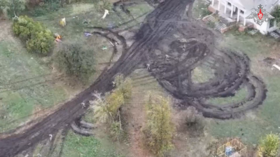Warships from Australia, Japan & US thunder into Indian Ocean for ‘Quad’ drills amid rising China tensions

Australia, India, Japan and the US have kicked off drills showcasing military hardware and tactical capabilities with warfare operations and live firing drills, as Beijing says it’s concerned for the region's peace and stability.
On Tuesday the four countries began the three-day Malabar naval exercises off the Visakhapatnam coast in the Bay of Bengal to strengthen coordination between their militaries amid increasing tensions with China.
The three-day exercise will involve anti-submarine and anti-air warfare operations, cross-deck flying, air asset refueling and live firing drills.
China however remains skeptical about the allied exercises. On Tuesday, Chinese Foreign Ministry spokesman Wang Wenbin reiterated Beijing’s hopes “that relevant countries’ military operations will be conducive to peace and stability in the region instead of the contrary.”
The US, India, Australia and Japan are utilizing a number of naval assets, including destroyers, frigates, naval helicopters and a submarine. Warships on show include the guided-missile destroyer USS John S. McCain and the equally immense JS Onami, the second of five Takanami-class destroyers commissioned by Japan between 2003 and 2006.
#Malabar_20@USNavy Ship USS John S McCain (Guided-missile destroyer), @Australian_Navy Ship HMAS Ballarat (long range frigate) & @JMSDF_PAO Ship JS Onami (destroyer) participating along with @indiannavy units.#SynergyatSea#MalabarExerciseFile Pics:- @COMAUSFLT@jmsdf_pao_engpic.twitter.com/h9HyS8kbQ5
— SpokespersonNavy (@indiannavy) November 3, 2020
The USS John S. McCain was joined by an Australian frigate last week for integrated operations before sailing to the Bay of Bengal together. Both ships conducted drills while transiting, including integrated tactical training and simulated warfighting scenarios.
The Indian Navy is represented by a sizable collection of assets during the exercise, including the 1980s destroyer Ranvijay, frigate Shivalik, offshore patrol vessel Sukanya, fleet support ship Shakti and submarine Sindhuraj.
The maneuvers also see Australian MH-60 and Japanese SH-60 helicopters demonstrate their tactical capabilities, undertaking refueling exercises on allied decks and anti-submarine drills.
Also on rt.com ‘Walk the talk,’ Beijing tells Washington, as military chiefs discuss tensions in South China Sea amidst Pompeo’s Asian tourThe Malabar exercises started in 1992 as drills between the US and Indian navies. Japan has participated permanently since 2015 and this year Australia is joining for the first time in 13 years in response to what it views as China’s increasingly aggressive stance in the region.
Beijing has also been concerned by the actions of the US and its allies in the region. China recently condemned Washington’s military exercises in the South and East China Seas as well as attempts to build strategic alliances with regional partners, including the sale of arms to Taiwan.
Further Malabar drills will take place later in November in the Arabian Sea.
Like this story? Share it with a friend!














